半平面交初级
来源:互联网 发布:丽水学院网络怎么样 编辑:程序博客网 时间:2024/04/29 16:16
半平面:顾名思义,半平面就是平面的一半,那么半平面应该如何表示呢?我们知道一条直线可以将平面分成两半,如果直线的方程为ax+by+c=0 ,那么半平面就可以表示为ax+by+c<0或者ax+by+c>0 ,如果我们这样定义半平面,那么半平面交也就很好解释了。半平面交:每一个半平面就是一个不等方程,那么半平面交就是满足这些半平面不等方程组的可行域。应用:现在了解半平面交的应用就是求多边形的核,那么多边形的核又是什么鬼?多边形的核就是在这个区域中的任意一点与多边形边的连线都在多边形的内部。就如同一个摄像头,将摄像头安装在这个区域的任意一点都可以看到多边形的任何地方。求解:那么明白了半平面交是什么鬼了之后,如何求解半平面交呢?- 假设现在我们有一个多边形
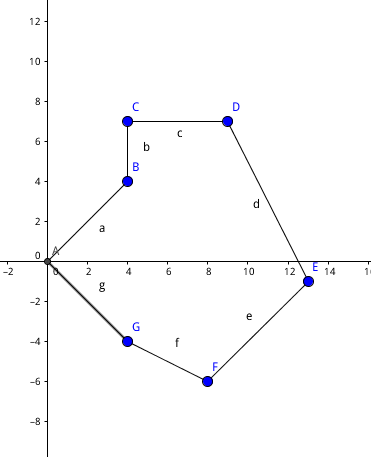
- 我们以AB为直线,那么属于半平面在下方,可以发现C不在半平面中,所以去掉C,但是AB与CD有一个交点,所以在半平面中多了一个点H,那么半平面交的点集为
A,B,H,D,E,F,G(顺时针) 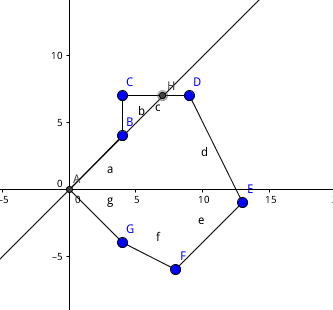
- 接下来我们以BC为直线,可以判断A不在半平面中了,所以半平面的点集为
B,H,D,E,F,G 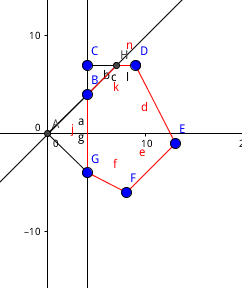
- 继续以上步骤,分别以相邻的点为直线来切割区域,去掉不在切割之后区域的点,增加新的交点。
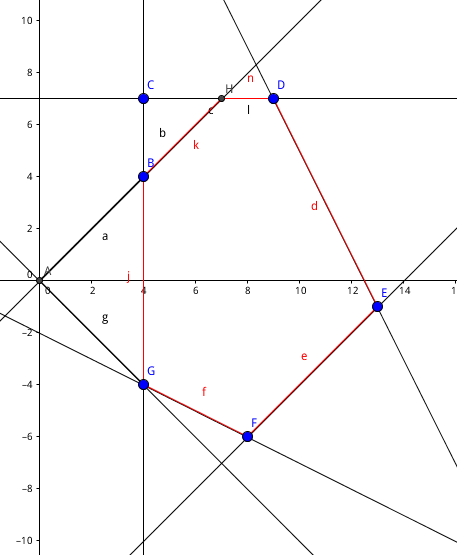
- 最后的到的红色线段围成的区域就是多边形的核(一个凸包)。
- 我们以AB为直线,那么属于半平面在下方,可以发现C不在半平面中,所以去掉C,但是AB与CD有一个交点,所以在半平面中多了一个点H,那么半平面交的点集为
例题
【POJ3130】How I Mathematician Wonder What You Are!
Time Limit: 5000MS Memory Limit: 65536K
Description
After counting so many stars in the sky in his childhood, Isaac, now an astronomer and a mathematician uses a big astronomical telescope and lets his image processing program count stars. The hardest part of the program is to judge if shining object in the sky is really a star. As a mathematician, the only way he knows is to apply a mathematical definition of stars.
The mathematical definition of a star shape is as follows: A planar shape F is star-shaped if and only if there is a point C ∈ F such that, for any point P ∈ F, the line segment CP is contained in F. Such a point C is called a center of F. To get accustomed to the definition let’s see some examples below.
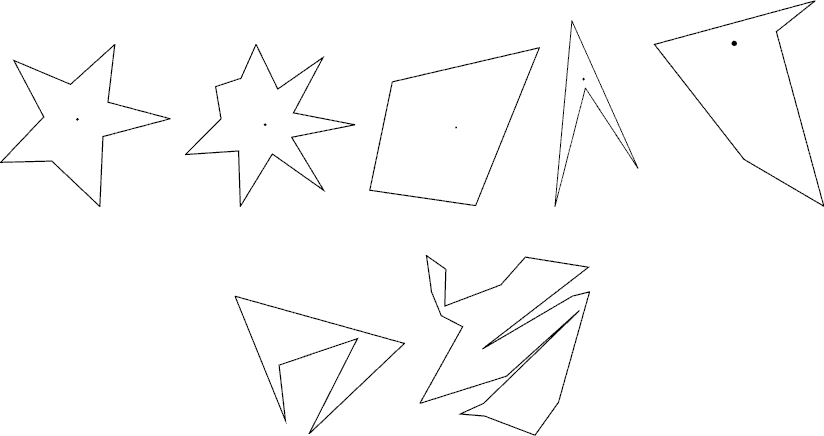
The first two are what you would normally call stars. According to the above definition, however, all shapes in the first row are star-shaped. The two in the second row are not. For each star shape, a center is indicated with a dot. Note that a star shape in general has infinitely many centers. Fore Example, for the third quadrangular shape, all points in it are centers.
Your job is to write a program that tells whether a given polygonal shape is star-shaped or not.
Input
The input is a sequence of datasets followed by a line containing a single zero. Each dataset specifies a polygon, and is formatted as follows.
n
x1 y1
x2 y2
…
xn yn
The first line is the number of vertices, n, which satisfies 4 ≤ n ≤ 50. Subsequent n lines are the x- and y-coordinates of the n vertices. They are integers and satisfy 0 ≤ xi ≤ 10000 and 0 ≤ yi ≤ 10000 (i = 1, …, n). Line segments (xi, yi)–(xi + 1, yi + 1) (i = 1, …, n − 1) and the line segment (xn, yn)–(x1, y1) form the border of the polygon in the counterclockwise order. That is, these line segments see the inside of the polygon in the left of their directions.
You may assume that the polygon is simple, that is, its border never crosses or touches itself. You may assume assume that no three edges of the polygon meet at a single point even when they are infinitely extended.
Output
For each dataset, output “1” if the polygon is star-shaped and “0” otherwise. Each number must be in a separate line and the line should not contain any other characters.
Sample Input
6
66 13
96 61
76 98
13 94
4 0
45 68
8
27 21
55 14
93 12
56 95
15 48
38 46
51 65
64 31
0
Sample Output
1
0
题意:判断多边性的是不是有核
思路:求出多边形的核,判断组成核的点是不是为零,为零则没有核。
#include <cstdio>#include <cstdlib>#include <cstring>#include <cmath>#include <string>#include <queue>#include <algorithm>#include <iostream>using namespace std;const double eps = 1e-6;const int Max = 55;typedef struct Point{ double x,y; Point(){} Point(double _x,double _y):x(_x),y(_y){} Point operator + (const Point &a)const { return Point(x+a.x,y+a.y); } Point operator - (const Point &a)const { return Point(x-a.x,y-a.y); } double operator * (const Point &a)const { return x*a.x+y*a.y; } Point operator * (const double &a)const { return Point(x*a,y*a); } double operator ^ (const Point &a)const { return x*a.y-y*a.x; }}Vector;Point P[Max];Point S[Max*10],T[Max*10];int dbcmp(double a){ return fabs(a)<eps?0:(a>0?1:-1);}int n;Point GetLineIntersection(Point p,Vector v,Point q,Vector w)//计算两条直线的交点。{ Vector u = p-q; double t = (w^u)/(v^w); return p+v*t;}bool JudgePolygonNucleus(){ int num1 = n; int num2; for(int i = 0;i<n;i++)//初始的多边形的核为他自己本身 { S[i] = P[i]; } for(int i = 0;i<n;i++) { num2= 0 ; for(int j = 0;j<num1;j++) { int ans1 = dbcmp((P[(i+1)%n]-P[i])^(S[j]-P[i])); int ans2 = dbcmp((P[(i+1)%n]-P[i])^(S[(j+1)%num1]-P[i])); if(ans1>=0)//通过叉积判断是不是在直线的某一侧,>0 在直线的左侧,<0在直线的右侧,=0 在直线上 { T[num2++] = S[j]; } if(ans1*ans2<0) { T[num2++] = GetLineIntersection(P[i],P[(i+1)%n]-P[i],S[j],S[(j+1)%num1]-S[j]); } } num1 = num2; for(int j = 0;j<num2;j++) { S[j] = T[j]; } } return num1!=0;}int main(){ while(scanf("%d",&n) && n) { for(int i = 0;i<n;i++) { scanf("%lf %lf",&P[i].x,&P[i].y); } if(JudgePolygonNucleus()) { printf("1\n"); } else { printf("0\n"); } } return 0;}【POJ3335】Rotating Scoreboard和上一道题意一样只是输出不同。
【POJ1474】Video Surveillance同上
【POJ1279】Art Gallery求核的面积
- 半平面交初级
- pku2451 半平面交
- 半平面交
- 半平面交
- poj2540 半平面交
- 半平面交
- poj2451 半平面交
- 半平面交.....
- 半平面交
- POJ3384+半平面交
- HDU1632+半平面交
- POJ3525+半平面交
- POJ2451-半平面交
- 半平面交
- 半平面交
- 半平面交
- 半平面交
- 半平面交
- bzoj 3609: [Heoi2014]人人尽说江南好 数学
- 泛型类的定义与使用
- 图的最短路径:Dijkstra、Bellman-Ford、SPFA、Floyd算法
- windows & Linux 下命令行查看端口占用情况并且关闭进程
- 面试题8:旋转数组的最小数字
- 半平面交初级
- 环境——卸载redhat6.5的yum,安装centos6的yum,配置第三房yum源
- Python 3.5.1发邮件
- 穷举法之完美综合式
- 链表的艺术——Linux内核链表分析
- 泛型方法的定义与使用
- 中国学者利用纳米人工红细胞精准治疗癌症获突破
- C++11——新特性总结
- 在Windows上安装TimesTen


